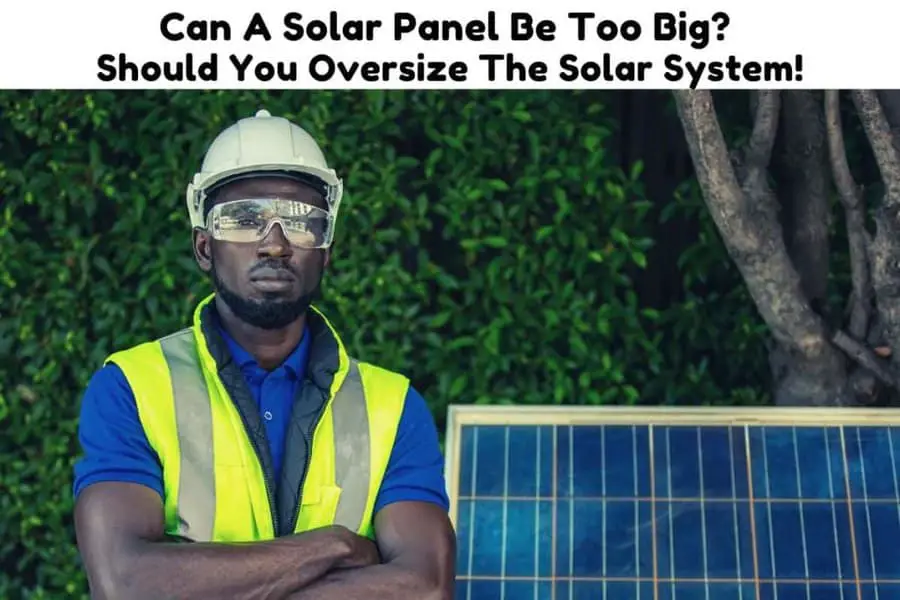A square foot of solar panel can provide enough energy to cover half the needs of an average U.S household. But what happens when you have too many solar panels? Can you oversize your solar system?
Can A Solar Panel Be Too Big?
It is much better to have too many solar panels than not enough. In fact, one should oversize their solar system if possible because oversizing solar panels allow for balancing out lost production. Due to high temperatures and variable available sunlight, solar panels experience a dip in the energy output of up to 10%. Oversizing compensates for the dip in energy loss.
Depending on your local climate you want your solar panels to be between 20 to 30% larger than your inverter when designing your system. If you live in a hotter climate, you want it to be at 30%. This is to mitigate the watt output loss due to high temperature.
On a side note! If you’re in need of a reliable and high-performance portable solar panel, We strongly recommend the Jackery SolarSaga 100W Portable Solar Panel (Amazon Link).
With a high conversion efficiency and foldable design, this solar panel is easy to transport and set up, making it perfect for outdoor activities like camping, hiking, and RV trips.

The US solar cell technology used in this panel ensures that you get the most efficient and reliable solar charging possible.
There is also a 60W option that is more affordable (Amazon Link)
The same rule can be applied depending on how much sunlight you receive. If you live in a climate with fewer peak sunlight hours you want to make your solar panels 30% larger than your inverter. This makes better use of the inverter’s capacity than matching it exactly. Source
In this article, we will show in detail why it’s a good practice to oversize our solar panels. We will also cover some of the most important steps you should take when sizing a solar system and what the right ratio or proportion for oversizing your system is.

What Happens If You Oversize Your Solar System?
Oversizing a solar system is good practice. Solar systems produce a variable amount of energy due to inefficiency or inadequate sunlight due to cloud cover or limited peak sun hours. Oversizing considers this and tries to make up for the shortfalls or variations in energy production.
A solar system is not a perfect system. It does not produce a completely consistent amount of energy. Your solar panels will rarely produce their rated watt output. There are two reasons for this:
- Energy production in a solar panel happens on a curve. It will be low in the morning before it peaks when the sun reaches its zenith and then it dips again in the late afternoon and evening. The panel will not produce its rated watt output during the off-peak periods of morning and evening.
- Solar panels experience efficiency loss due to shading or dirt reducing their light absorption or because of high temperature. Here, again the solar panels’ watt output decreases.
Solar panels are given a watt rating under standard test conditions. These conditions assume the solar panel will receive continuous solar irradiation of 1000 watts at 25°C. These are the ideal conditions at which a solar panel may be given a rating of 100, 250, or 300 watts.
In reality, however, your solar panel will not receive continuous solar irradiation at a steady temperature. Irradiation varies based on the time of day and what season it is. Temperatures will also vary. All this affects or determines the real watt output of your solar panel. You should expect to see a baseline efficiency loss of 10% in the watt output.
In short, solar panels will only rarely produce their rated output. Oversizing your system takes this into account by trying to make up for the difference by having more solar panels than needed.
Is A Larger Solar Panel Better?
Having a larger solar panel translates to an improved energy yield. It covers up for the shortfalls in energy production caused by either high temperature or varying solar irradiation.
The ideal conditions and the real conditions under which you will use your solar panel are different. Under the ideal conditions of a testing laboratory, your solar panel will consistently produce its rated output. In reality, out in the real world, it will rarely do so.
But how do you size a solar system? There are two ways based on whether your system will be grid-tied or off-grid.
Grid-tied & Off-Grid Solar System Sizing
Sizing a grid-tie solar system
A grid-tied system is where some of your electricity is supplied by your utility. The biggest difference between a grid-tie and an off-grid system is usually the inverter. Grid-tie systems use an inverter that switches off when the grid-supplied electricity goes down in a power outage.
Off-grid systems do not have this feature. Also, in an off-grid system you always need batteries whereas, with a grid-tie system, batteries are optional. Here is a basic outline of how to size your system.
Step 1: Work out your daily consumption
The first step to sizing your grid-tie system is to work out your consumption. The average U.S homeowner has a consumption of about 893 kWh per month. That means roughly 30 kWh per day. Source
Step 2: Work out how much sunlight you receive
This is an important step so you cannot skip it. Your daily solar irradiance or how much sunlight you get will give you an idea of how much output to expect from your solar panels. You can get this information from a sun hours chart or an online PV watt calculator or using Google’s Sunroof Project tool.
Step 3: Adjust for inefficiency
Once you know your consumption and sunlight hours you divide that and then multiply the result with the inefficiency factor. Here is what that looks like:
30 kWh (Consumption) / 5 (Peak sun hours) x 1.15 (Efficiency factor) = 6.9 kW system
Sizing an off-grid solar system
An off-grid system has greater energy demands because there is no fallback grid electricity. You would therefore approach sizing a little differently. The first two steps will be the same as with a grid-tie system except now you might want to be more generous in oversizing.
The main difference in the process is with an off-grid system is you need to add batteries into the mix for energy storage.
Can A Solar Panel Be Too Big For A Battery?
A solar panel can be too big for a battery. If a solar panel produces more current and voltage than the battery can take, it will overcharge the battery. Consistently overcharging a battery will eventually lead to irreversible damage.
This is where a charge controller comes in. Charge controllers regulate the voltage and current from your solar panels to your battery to prevent overcharging. There are two different types of charge controllers namely PWM and MPPT. The latter is the more recommended as it is the more efficient of the two.
